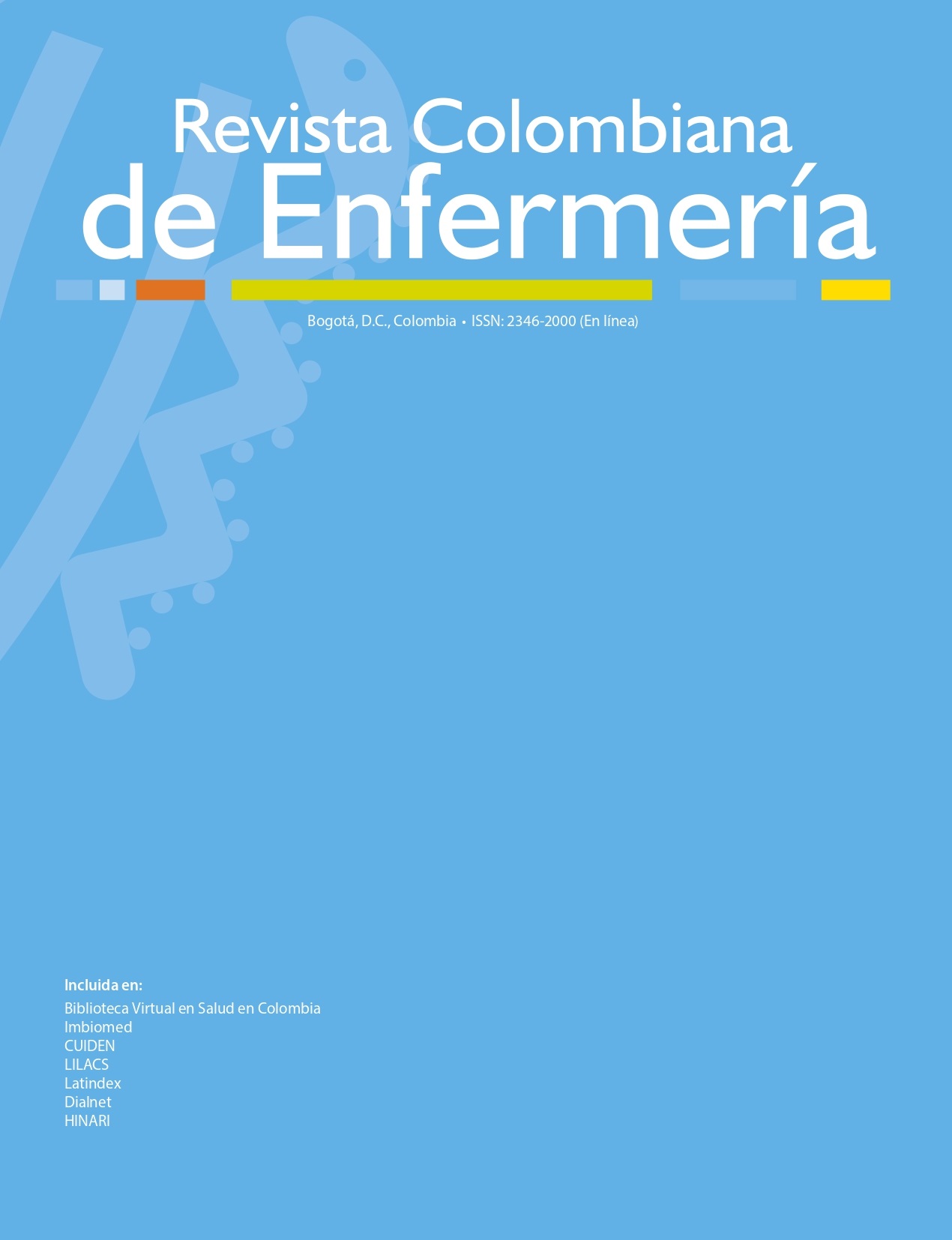Caracterización de los registros de atención en una institución prestadora de servicios de salud mental en Bogotá, 2001-2017
DOI:
https://doi.org/10.18270/rce.v22i1.3397Palabras clave:
servicios de salud mental, trastornos mentales, hospitalización, psiquiatría, Urgencias en salud mental, Hospital de diaResumen
Introducción: el abordaje integral de la salud mental es uno de los retos del país en salud pública, dado que la población colombiana ha presentado un deterioro en ese aspecto en los últimos veinte años de acuerdo con el documento CONPES 3992 del 2020. Objetivo: Caracterizar los registros individuales de prestación de servicios en atención de salud mental en una institución prestadora de servicios en Bogotá, Colombia, entre el 2001 y el 2017. Métodos: estudio descriptivo trasversal. Se usaron los registros individuales de prestación de servicios como fuente de información y se tuvo en cuenta clasificación internacional de enfermedades (CIE-10) En total de registros RIPS en salud mental, por equipo interdisciplinario: médico general, médico psiquiatra, enfermería, psicología, trabajo social y terapia ocupacional. Resultados: se analizaron 2.360.295 registros individuales de prestación de servicios en salud mental de la institución seleccionada. Según los registros, el promedio de edad de las personas atendidas era de 47 años y predominó el sexo femenino con el 52,5 %. Los servicios utilizados fueron hospitalización (49,82 %), consulta externa (43,42 %), urgencias (4,54 %) y hospital de día (0,39 %). El mayor número de registros (64,47 %) se presentó en el grupo entre los 18 y 59 años de edad; seguido del grupo de 60 años o más (28,50 %) y de menores de 18 años (7,03 %). Los grupos de diagnóstico principales fueron trastorno psicótico con el 33,38 %, depresión con el 15,39 % y ansiedad con el 13,71 %. Conclusiones: Son las mujeres quienes más utilizan el servicio (52.5%). Es la hospitalización el servicio más utilizado (49.82%). Son los adultos entre 18 y 59 años quienes más utilizan los servicios (64.47%). Se observa un progresivo incremento en el número de atenciones. Los trastornos mentales severos esquizofrenia y bipolar son los más atendidos (33.38%) seguidos de trastornos de depresión y ansiedad (29%). Las enfermedades medicas generales se presentaron en el (10.95%) de las atenciones.
Descargas
Referencias bibliográficas
-GBD 2016 DALYs and HALE Collaborators Global, regional, and national disability-adjusted life-years (DALYs) for 333 diseases and injuries and healthy life expectancy (HALE) for 195 countries and territories, 1990–2016: a systematic analysis for the Global Burden of Disease Study 2016. The Lancet. Vol 390 September 16, 2017
-Whiteford HA, Degenhardt L, Rehm J, et al. Global burden of disease attributable to mental and substance use disorders: findings from the Global Burden of Disease Study 2010. Lancet. 2013;382(9904):1575-1586.
- OPS-OMS. La carga de los trastornos mentales en la Región de las Américas, Washington, 2018 ISBN: 978-92-75-32028-0
- Whiteford Harvey, Ferrari Alize, Degenhardt Louisa. Global Burden Of Disease Studies: Implications For Mental And Substance Use Disorders. Health Affairs June 2016 35:6. 1114-1120
- GBD 2015. Disease and Injury Incidence and Prevalence Collaborators. Global, regional, and national incidence, prevalence, and years lived with disability for 310 diseases and injuries, 1990-2015: a systematic analysis for the Global Burden of Disease Study 2015. Lancet. 2016;388(10053):1545-1602. doi:10.1016/S0140-6736(16)31678-6.
-González Lina María, Enrique Peñaloza Rolando, Matallana María Alexandra, Gil Fabián, Gómez-Restrepo Carlos, Vega Landaeta Ángela Patricia. Factores que determinan el acceso a servicios de salud mental de la población adulta en Colombia. Rev.colomb. psiquiatr. [Internet]. 2016 Dec [cited 2020 Mar 06]; 45(Suppl 1): 89-95. Available from: http://www.scielo.org.co/scielo.php?script=sci_arttext&pid=S0034-74502016000500012&lng=en. http://dx.doi
-OPS/OMS. Atlas de Salud Mental de las Américas 2017. Washington D.C. 2018
-Organización Mundial de la Salud. Plan de acción sobre salud mental 2013-2020. Ginebra: OMS; 2013.
-Wainberg ML, Scorza P, Shultz JM, et al. Challenges and Opportunities in Global Mental Health: a Research-to-Practice Perspective. Curr. Psychiatry Rep. 2017;19(5):28. doi:10.1007/s11920-017-0780-z
- Ministerio de Salud y Protección Social. Encuesta Nacional de Salud Mental 2015 Tomo 1.Minsalud.http://www.odc.gov.co/Portals/1/publicaciones/pdf/consumo/estudios/nacionales/CO031102015-salud_mental_tomoI.pdf
- OPS. Clasificacion Estadistica de Enfermedades y Problemas relacionados con la salud. Decima Revision CIE 10. OPS. 2015
-Steel, C et all. The global prevalence of common mental disorder a systematic review and meta-analysis 1980-2013. Internacional Journal of Epidemiology. 476-493
- Ministerio de Salud. Boletín de salud mental Análisis de Indicadores en Salud Mental por territorio Subdirección de Enfermedades No Trasmisibles Grupo Gestión Integrada para la Salud Mental. Minsalud. Gobierno de Colombia.2018
- WBG/WHO. Out of the shadows: Making Mental Health a Global Development Priority. Seth Mnookin WBG/WHO. 2016
-Consejo Nacional de Política económica social Republica de Colombia, Departamento Nacional de Planeación. Documento CONPES 3992. Estrategia para la promoción de la salud mental en Colombia. Abril de 2020
Descargas
Publicado
Cómo citar
Número
Sección
Licencia
Derechos de autor 2023 Revista Colombiana de Enfermería

Esta obra está bajo una licencia internacional Creative Commons Atribución-NoComercial-SinDerivadas 4.0.
Derechos de autor
La Revista Colombiana de Enfermeríade la Facultad de Enfermería de la Universidad El Bosque es una publicación científica, de acceso abierto, y que permite la consulta, lectura, copia, distribución y exhibición de los textos completos de sus artículos sin costo alguno para los usuarios, esto en aras de fomentar un mayor intercambio de conocimiento global, siempre y cuando se dé testimonio de la autoría del mismos y no se busque la obtención de beneficios comerciales por parte de terceros. Ni la Revista ni la Universidad asumen responsabilidad alguna por los puntos de vista expresados por los autores. Los nombres de equipos, materiales y productos manufacturados, incluyendo fármacos que eventualmente puedan mencionarse, no implican recomendación ni propaganda para su uso y sólo se mencionan como identificación genérica.
Los autores ceden sus derechos patrimoniales a la revista. Los manuscritos se publican bajo una Creative Commons Attribution License que permite a otros compartir el trabajo con un reconocimiento de la autoría del trabajo y la publicación inicial en esta revista.












